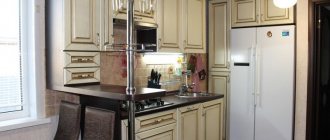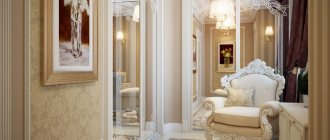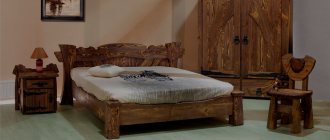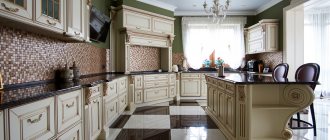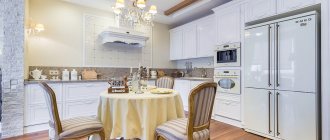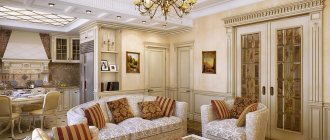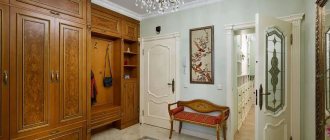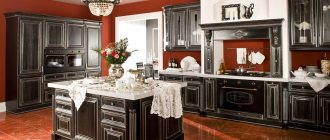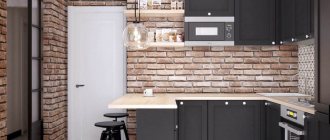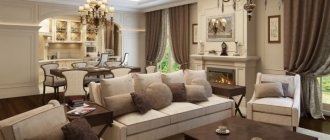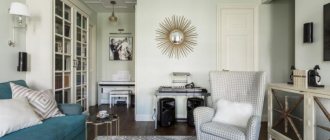New furniture - dining table, chairs, cabinet - looks brilliant, beautiful, interesting, in general - like new. Oddly enough, in many styles novelty is not considered an advantage. After all, furniture is interesting for its uniqueness, and the latter is often associated with the time of use, rather than production technology or the characteristics of the material.
As a result, a kitchen with patina and artificially aged facades seems much more attractive than a perfectly new one.
Patina Features
Patina appears on the surface of various products as a result of the natural process of oxidation. Over time, metal and wooden products can become covered with plaque and cracks, and sometimes a blackening effect appears. Such a set looks like an expensive antique, however, the natural oxidation process can last for decades. That is why people have come up with a lot of ways to artificially age furniture. One of them is covering wood with artificial patina of different colors. To do this, use a combination of various acids, paints and varnishes.
Creating a decorative coating
It takes a long time for furniture to become covered with a natural patina. In addition, not all materials are covered with this natural coating. Products made of copper are exposed to the best impact.
But what if we are talking about a kitchen made of wood? Modern techniques for artificially applying patina come to the rescue.
Using specially selected paints, enamels and acids, craftsmen manually increase the “life” of newly born furniture. The result does not need to be expected for decades. Everything happens in a matter of minutes.
Pros and cons of patina in the kitchen
The advantages of patination of furniture include the following:
- Durability. The set is less susceptible to wear and tear - varnish applied to the patina in several layers perfectly protects the wood from moisture and other influences.
- Practicality. Furniture with patina looks expensive, but does not require special care. In addition, the antique effect perfectly masks minor scuffs and cracks.
- Availability. Instead of buying a real antique, you can buy a set with a patina, which costs much less, but at the same time looks much like furniture that is decades old.
The disadvantages of applying a patina to the surface of a kitchen unit include the fact that this substance is highly flammable. It is better to equip such an interior with an electric stove rather than a gas one. In addition, it is better to remove decorative candles and candlesticks from the kitchen. The wiring is carefully insulated to prevent fire.
Advantages and disadvantages
If you are wondering whether to choose a set with a golden patina for your wonderful home, we will present to your attention its advantages:
- durability _ For many years, furniture facades will delight you with their impeccable appearance;
- wear resistance A very important factor for the kitchen, where the level of humidity and temperature changes. Thanks to layers of protective varnish, the appearance of the headset will not be damaged by external influences;
- originality; your home will be unique in design;
- low price . Real antiques are available to a small part of the population, but using this decorative option will make it possible to age any piece of furniture at a low cost.
In addition, such surfaces are quite easy to care for - regular wet cleaning is enough.
An undoubted advantage will also be that artificially aged furniture will be tolerant of small errors in appearance - unevenness, roughness, etc. Agree, it’s a pleasure to spend time cooking without worrying about the impeccable appearance of the kitchen set.
Speaking about the advantages, we will also touch on the disadvantage - its flammability. The main thing is the well-being of your household; please follow fire safety rules.
Types of patina
Despite the fact that patina is presented on the market in a wide variety, only a few types are the most popular. They are distinguished mainly by shades and decorative effect.
Golden and silver
Gold and silver on a kitchen set is a universal option that matches almost any color of furniture. However, this patina reveals its fullest potential on a white or black surface. The substance also looks impressive on light wood.
Important! Compositions of golden and silver shades are coated with matte varnish, and not glossy, as is customary with other colors.
Contrasting
Contrasting compositions are designed to most effectively highlight carvings and relief areas on furniture. For these purposes, it is recommended to use copper, bronze, gold and silver patina. When self-patination, the substance is first rubbed onto the joints of the frames and panels, after which they move on to the rest of the elements of the set. Then apply another thin layer on top of the main one.
Craquelure
A coating with a craquelure or crackle effect is best suited for kitchens in Provence, country or shabby chic styles. At the same time, the surface of the furniture is characterized by many small cracks - this effect is achieved due to the varnish coating, which cracks as it dries. As a result, the set looks as if it was covered with old paint.
A patina is applied over the cracked layer, which fills all the recesses and gives the kitchen furniture a special decorative effect.
Combine the incongruous
The next point in creating your ideal kitchen is the selection of materials for furniture facades.
Lacquered and smooth models would be preferable. The fact is that such a technique will visually expand the space, while leaving it bright and cozy.
Wood or chipboard are the immortal leading classics. Absolutely any minimalistic and discreet fittings will suit them.
Moreover, it will not be difficult to fit even the latest stove, oven or microwave into such furniture with a standard discreet form.
Black, white, and metal versions of this “filling” will look equally appropriate.
Another rather old, but at the same time eternally relevant technique is the combination of smooth surfaces, for example, with weaving. This way you can freshen up your standard cabinet doors.
Several of them can be made with a non-standard wicker surface or, conversely, decorated in frosted glass.
After all, glass surfaces always harmonize best with the ultra-new technical equipment of the kitchen.
However, perfectionists now have many opportunities to minimize the incompatibility of textures and materials. Today it is no longer difficult to find a stove and, for example, an ivory-colored hood. Such elements are guaranteed to fit into the interior.
However, a combination of at least two shades in the design is preferable. This means that even such contrasting things as ivory-colored furniture and all the equipment in black will definitely complement each other.
Color palette for a kitchen with patina
The choice of a specific shade for furniture depends on the overall style of the interior. For a kitchen in a classic style, a white set is suitable. Wood and pistachio tones will fit perfectly into a Provence style interior.
White
In a kitchen with white furniture, green, blue and purple patina looks impressive. Gilding or silver composition can add special luxury to a white set. The panels add elegance to the furniture.
Be sure to use details in cream, beige and brown tones with gold. Panels will help make facades more elegant.
The interior of a light kitchen with a patina in a classic style is shown in the photo below.
Black
A black set is a very unusual and bold solution, however, it is not suitable for every interior. It is better not to furnish a small kitchen with such furniture - black color will weigh down the already small space and narrow it. If the kitchen is light and spacious, then you can safely order a black set with patina. For decoration, compositions that imitate silver and gold are best suited. White compositions for covering furniture are also suitable.
Beige
A beige set is usually covered with a patina of the following shades:
- gold;
- grey;
- pale blue;
- green;
- lilac.
This combination looks impressive in a Provence and shabby chic style interior. Golden compositions are suitable for classic kitchen design.
Gray
For a gray kitchen, the best patina is the following tones:
- black;
- blue;
- white;
- green.
Patina effectively enhances the discreet gray color of the furniture and gives it a luxurious look. With proper design, such a set can result in a very beautiful interior design in a classic style. Another advantage of a gray kitchen is the fact that this shade looks equally good in a room of any size.
Green
Green furniture with patina is characteristic of the light shabby chic style. Aged furniture in greenish shades will look no less impressive in country style, especially pistachio and olive colors.
Light tones of green add lightness and airiness to the room. They harmonize well with the patina of the following colors:
- beige;
- grey;
- blue;
- brown.
Advice! Indoor plants against a green background can be somewhat lost in the room.
Red
Red color for a kitchen with patina is a rather bold decision. Such a bright color should be handled extremely carefully so as not to overload the interior with unnecessary decor. Red furniture with an antique effect fits best into country style. In this case, it is advisable to choose not bright colors, but slightly muted ones. For example, a dark burgundy set with a muted bronze or gold patina looks very impressive.
In general, the red color of furniture goes well with the following shades of patina:
- white;
- black;
- grey;
- terracotta;
- beige;
- brown.
There should be a minimum of additional decor in such an interior.
Beauty and practicality
Briefly speaking about the color itself, it is something between warm white and beige shades.
Many housewives initially do not accept various design options in this shade, considering it too easily soiled.
In fact, this color is not just beautiful, but also incredibly practical.
Its peculiarity is that, unlike dark colors, dust is absolutely invisible on it, and unlike pure white, small debris, grains and crumbs are invisible on it.
Naturally, how easy it will be to keep a particular surface clean depends primarily on the material. But the color itself is so practical that it will suit even the busiest kitchen.
Finishing the floor, walls and ceiling in the kitchen with patina
If the furniture is covered with patina, it is necessary to highlight it due to the surrounding environment. In particular, this effect can be achieved with the help of discreet colors of the walls, floor and ceiling.
A kitchen with a patina in the Provence style is usually covered with wallpaper with a rough texture. The interior, designed in a classic direction, involves a combination of basic colors of the environment with neutral tones.
The kitchen ceiling with a patinated set is usually white, which visually expands the space and does not overload it. In general, the ceiling covering should be a couple of shades lighter than the walls and floor.
The apron (the area that separates the wall cabinets from the work surface) is usually covered with washable wallpaper or covered with ceramic tiles. Alternatively, you can decorate this area with stone or its imitation.
Important! Under no circumstances should you make a plastic apron in the kitchen with a patina. Plastic deprives the classic style of elegance, and Provence - naturalness.
Basic rules of care
Modern materials and surfaces are maximally functional and easy to use. They do not require any additional care.
As in any other room, the rule in the kitchen is: “Clean, not where it is often cleaned, but where it is not littered.” So you should treat kitchen furniture with special care, and it will serve you for a very long time.
The basic rules include the following:
- wooden surfaces should be wiped with a semi-dry soft cloth;
- plastic is washed with a damp cloth;
- the countertop is cleaned regularly with a wet cloth and then wiped dry;
- do not use aggressive chemical liquids to clean surfaces;
- do not use large abrasive products;
- Avoid prolonged direct exposure of the surface to steam and hot air.
Follow these simple rules and your kitchen will last a long and reliable life.
Tables and chairs for the kitchen with patina
A kitchen set with a patina looks great together with chairs and tables, which also have an antique effect. Furniture with decorative carvings, the motifs of which echo the decor of the set itself, is also suitable.
Advice! For a kitchen in the Provence style, you can purchase wicker chairs, which will only enhance the notes of this trend.
Unique features of patinated kitchen sets
Patina is an original and colorful coating that can turn the most ordinary furniture into an object of admiration.
It not only changes the shade or texture of the kitchen facade, but also transforms the entire room.
Distinctive, unique features of aged sets are the following:
- Scuffs.
They evoke thoughts about the long history of the subject.
- Heterogeneity of the coating.
Thanks to the surface texture, the patina looks very colorful and unique. It fills all the unevenness and thereby repeats the relief of the base.
- Small cracks.
This is perhaps one of the most obvious signs of antiquity.
A gold or silver patina can not only add a touch of luxury to the kitchen environment, but also successfully complement the matte surface of the set.
Kitchen appliances
Furniture with patina does not fit well in appearance with modern household appliances, so all equipment is usually hidden behind facades.
The refrigerator and stove should match the tone with other interior elements. For example, you can install white appliances in an interior with light walls and furniture. In a kitchen with a lot of red, green or black, metallic will look better.
With black or brown tone
They contrast with ivory, so this combination looks especially impressive. Ivory very successfully smooths out the imperfections of the black tone, which is designed to optically conceal the space.
If ivory predominates in tones, and there are relatively few black or chocolate colors in the kitchen interior, designers recommend using this arrangement for small kitchens.
Note!
- Blue color of the kitchen - ideas for combining blue color in the kitchen + 130 photo reviews with decor options
Turquoise kitchen: TOP-150 photos of fashionable turquoise kitchen design ideas + reviews of stylish interiors
- Light green kitchen - TOP 130 photo reviews of light green kitchen design and decor. Features of the style of furniture and decor in the interior
Selection of decor and accessories
The selection of interior decorations largely depends on the style in which the kitchen is designed. The classic direction automatically excludes the abundance of additional decor - in such an interior, the patina itself, expressive lampshades and carvings on the kitchen set act as decoration. You can dilute pastel colors with the help of green accents - indoor plants. In addition, bright textiles look impressive in a bright kitchen with patina: curtains, upholstery, napkins, etc.
If the kitchen set has discreet shades, almost any upholstery color will suit it. In a kitchen where there is a lot of green or red, it is better to use curtains of the same shades; light colors are also suitable. The latter option goes well with almost any color of furniture.
Advice! The interior of a Provence style kitchen can be decorated with pastel-colored fabrics with simple patterns. Curtains whose color matches the color of the patina look impressive in such an interior.
Advantages of furniture patination
Let us briefly touch on the main advantages of artificial aging of furniture sets:
- high wear resistance;
- durability;
- uniqueness;
- affordable price.
Disadvantages include easy flammability; we advise you to especially carefully follow fire safety rules, this will give you and your household confidence and peace of mind.
Lighting rules
A kitchen with antique-style furniture does not tolerate poor lighting. The lack of light makes the interior faded and largely reduces the decorative effect of the patina to nothing. The room should have at least two light sources, while chandeliers and lamps of luxurious shapes will fit well. This design will perfectly complement the classic style, which is replete with white tones.
Ivory in different styles
Ivory fits perfectly into all interior styles without exception. It looks especially interesting in classics. Ivory perfectly fills the space with colors if the kitchen is “romantic”. Ivory is also suitable for modern, loft, high-tech, eclecticism and even pompous empire style.
Interior styles for kitchens with patina
Patina gives furniture an antique look, the illusion that it is many years old. Consequently, arranging a kitchen in modern styles, for example, high-tech, automatically excludes patination of the set. This effect looks good in the interior of the following areas:
- Provence;
- retro;
- classic;
- shabby chic;
- country.
Depending on the interior in which patina is used, preference is given to different colors.
Classic
Classic-style kitchens are distinguished by an abundance of white and its variations: beige and cream shades. This interior design allows you to visually expand the space, which is especially important for decorating a small kitchen.
In addition, the classic style includes the following characteristics:
- interior design involves the use of natural materials;
- the color scheme is restrained, even accents should not be too bright and colorful;
- furniture can be either laconic and strict in form, or, conversely, have a rather elaborate decor;
- Kitchen wall cabinets should ideally reach the ceiling;
- glass cabinet doors should be frosted so that only the general outlines of the dishes can be seen;
- electrical appliances must be built into the furniture.
A classic-style kitchen is best combined with a patina in neutral tones - gray, greenish, bronze. Gold and silver patina is the most luxurious option, however, these colors should not be overused. Such furniture will look tasteless in a kitchen that is replete with additional decor: paintings in carved frames, candles, figurines, painted dishes, patterned wallpaper, etc.
Advice! Bronze fittings will fit perfectly into the interior of a classic kitchen with white furniture: faucet, appliances, chandelier, etc.
Provence
The Provence style kitchen is characterized by the following features:
- the furniture has soft, rounded lines;
- preferred furniture color – white, cream, creamy, sand, champagne, pistachio, light blue, light yellow;
- the classic version of the Provence style involves the use of oak furniture, however, now this direction is more democratic;
- The facade of furniture is often decorated with wickerwork and latticework.
The patina of yellow and brown shades goes best with a Provence style kitchen. Furniture covered with gold patina looks no less impressive in such an interior. Patination with a craquelure effect is very popular when decorating a kitchen in the Provence style. Many small cracks look very impressive in combination with soft tones and lines, creating an atmosphere of comfort and warmth. At the same time, craquelure gives the kitchen set sophistication and high cost.
Advice! Notes of Provence can be enhanced with painted ceramic handles on the kitchen set.
Multifaceted shade
So, today we will talk about a kitchen in an unusually delicate and sophisticated, and at the same time aristocratically restrained ivory color.
Definitely, such a color scheme will be a win-win option for kitchen design.
The color “ivory”, as it is also called, is quite ambiguous in itself.
On the one hand, it is a warm shade of white that can soften any interior design and create an atmosphere of warmth and homeliness.
It will create the perfect combination with almost any other shade.
Plus, it's a truly versatile color.
Regardless of what colors and what tones predominate in the interior of the rest of the house, the ivory color will smooth out any transition of different textures and shades, and create the illusion of a smooth flow from one zone to another.
It is this color that will allow you to combine materials and decoration, designs and styles.
A kitchen decorated in this color will always look fresh and clean.
However, this shade also has a downside. The fact is that such muted light colors will look cold in any case.
However, this is not always a bad thing. The task of any type of design is to turn the features or disadvantages of a particular material into its advantages. This is exactly how you can play with the color “ivory”.
First of all, choosing such a fresh shade will make the room visually lighter, more spacious and lighter. Which is very preferable for small spaces.
And the truly golden combination in this case will be the combination of a cool ivory color undertone and a visual illusion using glass surfaces. This is how we will make the space fuller and more voluminous. Such an environment will not put pressure or oppress, but on the contrary, it will give only light and endless joy.
DIY patina in the kitchen interior
The safest thing to do would be to give the furniture for patination to a specialist or order a kitchen set already with patina, however, if you wish, you can apply it yourself - giving the kitchen an antique effect is not so difficult if you strictly follow all the instructions.
Patina is applied to the surface of the headset according to the following scheme:
- First, the solid wood façade is tinted or painted. Furniture made from MDF is pre-coated with enamel, veneer or PVC film.
- After this, a transparent primer is applied to the facade.
- As soon as the soil dries, it is sanded.
- After this, the kitchen set is covered directly with patina.
- The next stage is grouting. The facade must be wiped with a special scraper, a hard sponge or even a steel wool.
- The process is completed by applying varnish. It can be either matte or glossy. Typically, polyurethane varnish is chosen for patination - it effectively protects the wood in the kitchen from moisture. The varnish is applied in several layers, usually 2-3.
Important! The antique effect increases depending on how intense the sanding was.
The patination process is described in more detail in the video below:
We age the façade ourselves in 7 steps
With certain skills and a great desire, you can apply patina to furniture with your own hands. And in this section you will learn how to do this.
| Illustration | Instructions for action |
| Step 1. Sanding . The first step is to sand the façade using a sanding machine and a 180-grit disc. | |
| Step 2. Applying stain . Using a professional sprayer or atomizer, apply an even layer of wood stain to the surface of the façade. | |
| Step 3. Applying varnish . For these purposes, it is necessary to use a self-priming varnish. The best varnish is FL25M306. After applying the product, wait an hour. | |
| Step 4: Re-sanding . After the layers of stain and varnish have dried, sand the surface. | |
| Step 5. Applying a patting composition . Using the same sprayer, apply the patina to the façade in a crisscross motion. | |
| Step 6: Creating scuff marks . Carefully sand the surface of the façade with sandpaper. | |
| Step 7. Consolidate the result . Once the scuffs are created, cover them with a final coat of varnish and let it dry. |
Kitchen design ideas with patina
Furniture covered with patina will fit perfectly into a room with a different design style. Below are examples of interior design that can serve as a great source of inspiration.
